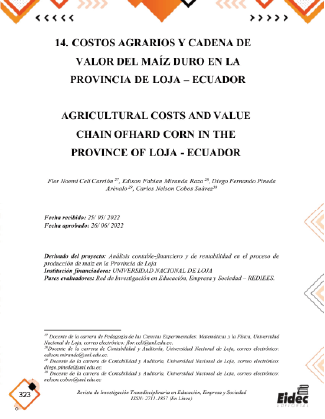XIV. AGRICULTURAL COSTS AND VALUE CHAIN OFHARD CORN IN THE PROVINCE OF LOJA - ECUADOR
##plugins.themes.bootstrap3.article.main##
Abstract
The present research address about the centers of production activities,
considering the value chain and the phenological cycle of the cultivation of corn. Since
the activities that takeplace in the cultivation of the grass are analyzed taking into account
the processes involved in the production phases for agricultural activities, such as:
planting, cultural work and harvest,the stated objective determines the cost - benefit
relationship in the production of corn in three places of the province of Loja to generate
information on the productive processes that the actors carry out and quantify the
determination of the cost for the agricultural activities carried out, considering existing
strengths and opportunities in the research area. Research methods and techniques were
used to establish inclusion criteria, social and economic environment, among others,
information collection instruments were prepared, such as surveys that were applied to
small, medium and large producers through focus group techniques of production and
maize cultivation process and the phenological cycle in its different phases. The main
result of the research was the description and analysis of the activity centers and the
production costs, concluding that the producers of the investigated places comply with
the same activity centers due to the cultivation is carried out once a year in winter
seasonand with traditional methods.
Download Statistics
##plugins.themes.bootstrap3.article.details##
Activity centers, Value chain, Phenological process, Sustainable development, Agricultural costs
0201.0057. Quito: Publicación Digita Intercalidad.
Asamblea Nacional del Ecuador, (2017). Ley Orgánica de Agrobiodiversidad, Semillas
Y Fomento De Agricultura. Registro Oficial Suplemento 10 De 08-jun.-2017.
Quito: Lexis Finder.
Banco Mundial, (2016). Informe Sobre El Desarrollo Mundial Agricultura Para El
Desarrollo. Washington, Da: Panorama General.
Caviedes Cepeda, G. M. (2019). Producción de semilla de maíz en el Ecuador: retos y
oportunidades. ACI Avances En Ciencias E Ingenierías, 11(1), 116-123.
https://doi.org/10.18272/aci.v11i1.1100
FAO (Food and Agriculture Organization of the United Nations) (2018). Producción
agrícola mundial obtenido de Organización de las naciones unidad para la
alimentación y la agricultura. https://www.fao.org/home/en/
FAO. 2015. Desarrollo de cadenas de valor alimentarias sostenibles: principios rectores.
Roma.
Hidalgo, H. (2009). Soberanía alimentaria, constitución y leyes. Colectivo Agrario.
Instituto Nacional de Estadísticas y Censos. (INEC) (2018). Encuesta de superficie y
producción agropecuaria continua. Boletín técnico Nro. 01-2018-ESPAC
Instituto Nacional de Estadísticas y Censos. (INEC)
(2020). Boletín Técnico de Encuesta de superficie y
producción agropecuaria continua, 2020.
bit.ly/3LAPXMM
MAGAP (2016). La Política Agropecuaria Ecuatoriana. Hacía el desarrollo territorial rural
sostenible: 2015-2025. Quito: Ministerio de Agricultura, Ganadería, Acuacultura y
Pesca. Online: https://bit.ly/ 2WVzs5T.
Munguía-Aldama, J., Sánchez-Plata, F., Vizcarra-Bordi, I., Rivas-Guevara, M. (2014).
Estrategias para la producción de maíz frente a los impactos del cambio climático.
Revista de Ciencias Sociales.
Núñez, J., Martín, V. (2015). Metodología de la encuesta de Superficie y Producción
agropecuaria contínua ESPAC 2014. Instituto Nacional de Estadística y Censos
(INEC. BM) Quito.
OECD/FAO (2020), OCDE‑FAO Perspectivas Agrícolas 2020‑2029, OECD Publishing,
Paris, https://doi.org/10.1787/a0848ac0-es.
Padilla, R. (2014). fortalecimiento de las cadenas de valor como instrumento de la política
industrial. Santiago de Chile: Comisión Económica para América Latina y el
Caribe (CEPAL).
Porter, M. E. (2007). Estrategia Competitiva, técnicas para el análisis de los sectores
industriales y de la competencia. Editorial Patria. Trigésima séptima reimpresión,
México.
Quintero, J., Sánchez, J. (2006). La cadena de valor: Una herramienta del pensamiento
estratégico. Telos [en línea]. ISSN: 1317-0570. Disponible en bit.ly/3MGhf5z
Ree, S., Jason, D., Dietmar, S. (2013). Evaluación de impactos del desarrollo de cadenas
de valor sobre la pobreza. Obtenido de Estudio de caso basados en la herramienta
Capitales. Serie Técnica Boletín Técnico no. 69. Colección de Desarrollo
Empresarial Rural no. 8
Zambrano, J. L. & otros (2019). Situación del cultivo de maíz en Ecuador: investigación
ydesarrollo de tecnologías en el INIAP [Resumen]. Ponencia presentada en XXIII
Reunión Latinoamericana del Maíz y IV Congreso de Semillas (p. 30-31).
Mosquera, Colombia:AGROSAVIA





